Winter Gardening
Tips and Guidelines Specific to Your Zone
Do you long for the taste of fresh garden salad when the days are short? If so, it may be time to learn something our ancestors knew and people are rediscovering nationwide: the joys of winter gardening.
It may be hard to believe, but bountiful winter harvests are possible nearly everywhere in the continental United States. Winter gardeners even enjoy some benefits over their fair-weathered brethren. Many pests hibernate or migrate when the weather gets cold.http://www.extension.umn.edu/garden/insects/find/insect-strategies-to-survive-winter/ Weeds grow slower. And because of low light and less evaporation, plants usually need far less water in the winter.http://www.fourseasonfarm.com/pdfs/garden_for_all_seasons.pdf, https://eattomorrow.com/blog/2014/10/winter-gardening-tips-best-winter-crops-cold-hardy-varieties/
But how do vegetables survive snow, howling winds, or torrential rain? Successful winter gardeners must follow three essential steps:
- Plant cold-hardy vegetable varieties
- Protect them from the elements
- Know when to plant them
Read on to learn about veggies that thrive in the cold, and the simple devices that can shelter them. Then find specific plant timing information and climate considerations for USDA Hardiness Zones 4 through 9, where most cold-season gardeners live.
Cool Season Veggies
Attempting to grow summer crops, such as tomatoes, peppers, or melons, outdoors in the winter is a recipe for disaster. Instead, plant the following cold-tolerant crops, which thrive when the temperatures dip. They’re divided into slow-maturing, middle-maturing, and quick-maturing crops, which is useful when timing plantings for your region. (These maturation lengths are estimates; check seed packets for specific information.)
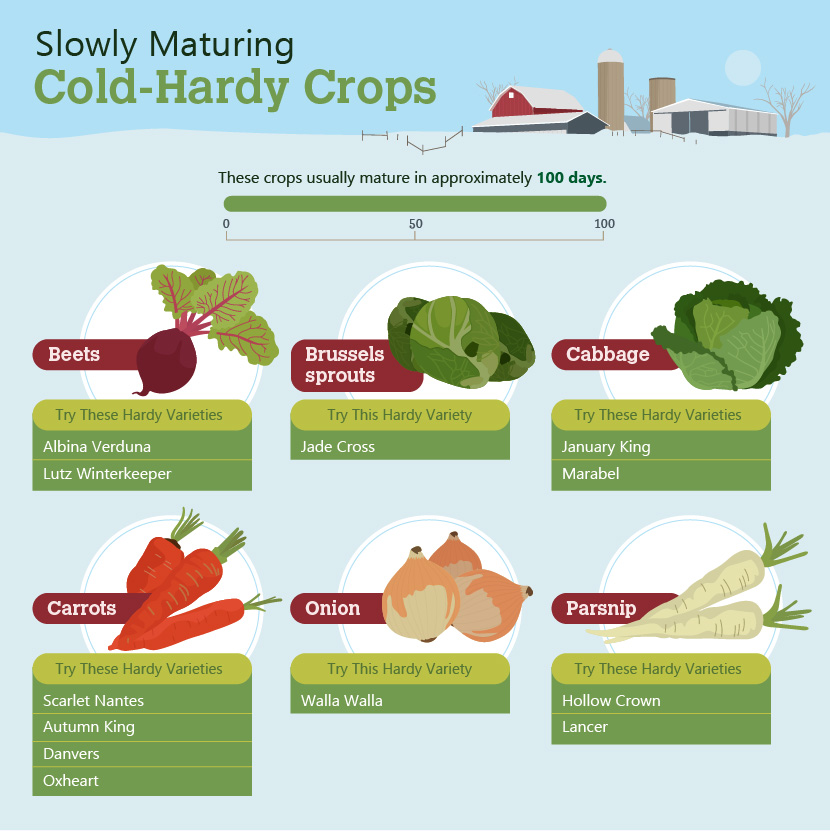
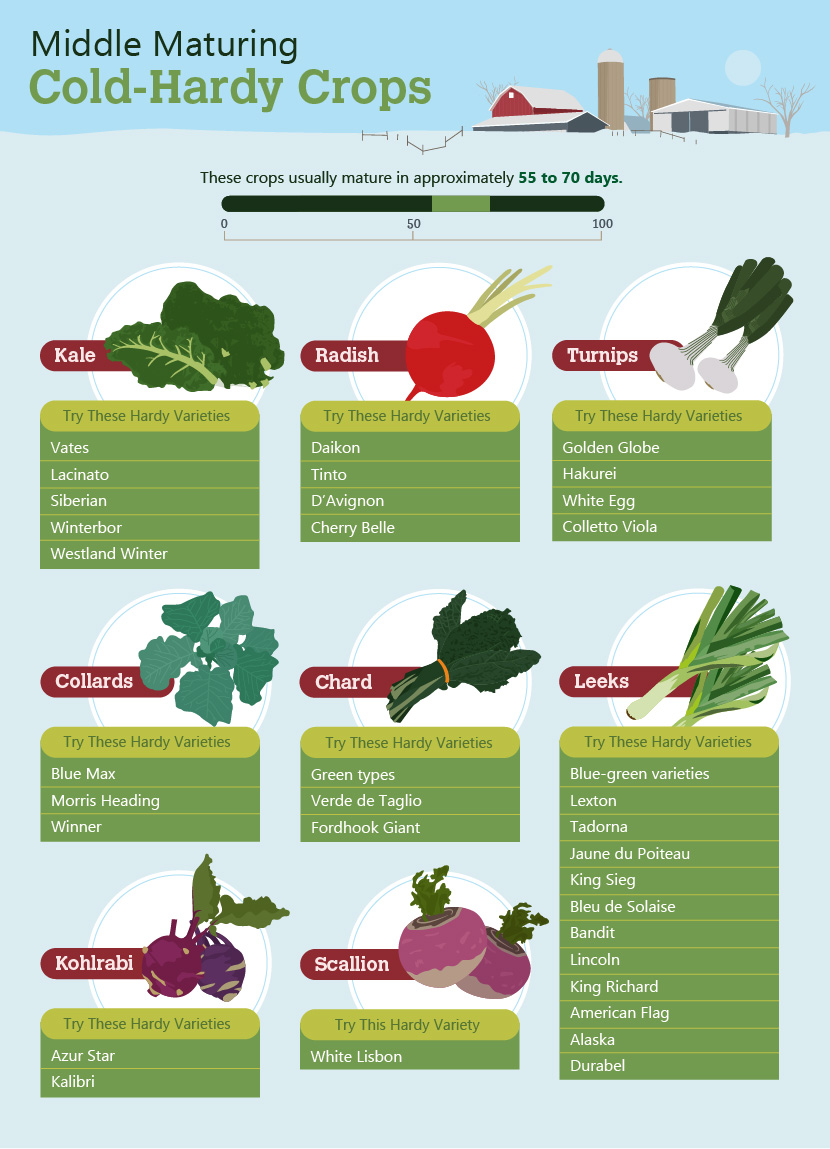
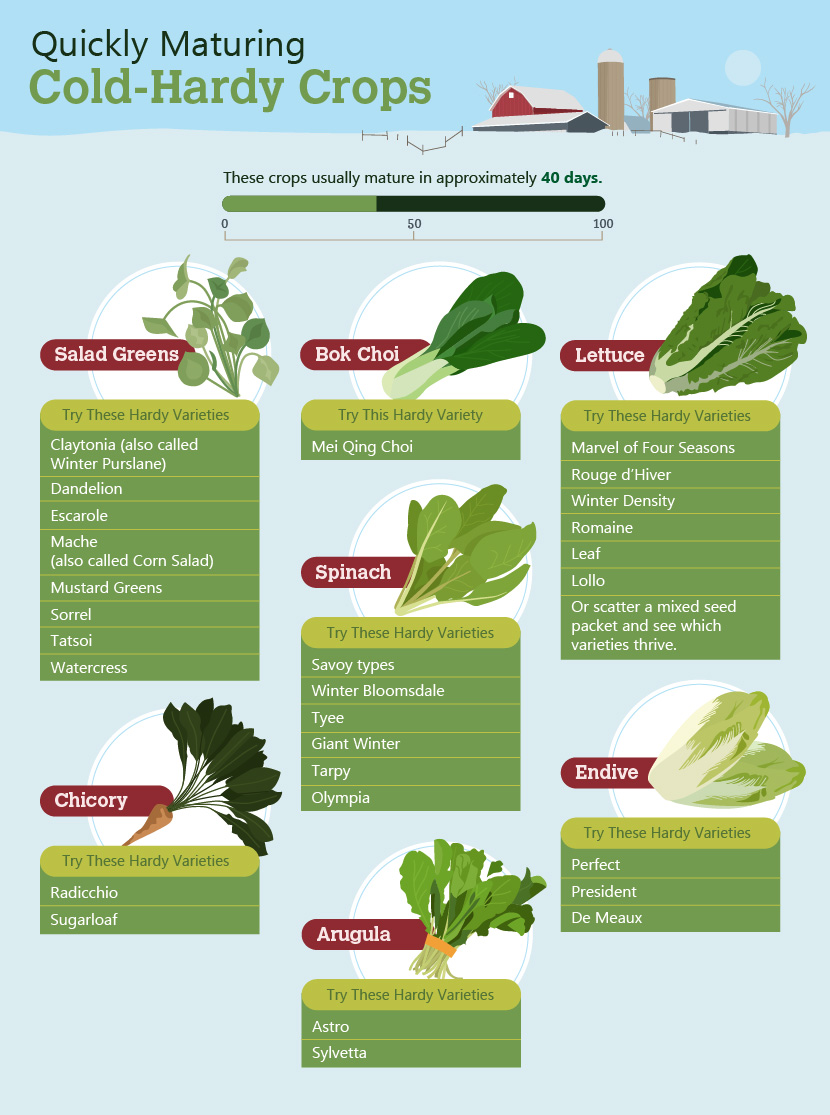
Protecting the Winter Garden
You don’t need high-tech devices to protect winter crops from the elements. Simple, inexpensive materials do the job, and most of them can be added to an existing vegetable garden. Four-Season Harvest author Eliot Coleman points out that cold-hardy plants don’t necessarily need warmth during the cold months. They need protection from wind, excessive moisture, and extreme temperature fluctuations.Coleman, Eliot, Four-Season Harvest, Chelsea Green Publishing, 1992, pg. 65
It may sound counterintuitive, but warmth can actually be more destructive to winter gardens than cold. Conditions inside many of these protective devices can quickly become sweltering on a warm, sunny day and kill plants. It’s crucial to open devices to allow ventilation. Coleman advises winter gardeners to err on the side of too cold rather than too hot.Coleman, Eliot, Four-Season Harvest, Chelsea Green Publishing, 1992, pg. 65

Winter crops often do best when several protection devices are combined. Start with the least protection you think is needed and see how plants do, then add more protection as necessary. For instance, mulch plants and cover them with a row cover, then invest in a hoop tunnel if needed. Or start with a cold frame and add a string of Christmas lights to turn it into a hot box during a cold snap.
When to Plant Winter Crops in Your Zone
Find your zone on the USDA’s Plant Hardiness Zone Map and scroll down for planting dates and considerations for your zone.http://planthardiness.ars.usda.gov/PHZMWeb/ The key to a thriving winter garden is to plant crops soon enough that they have time to mature before the first killing frost. That’s why knowing the approximate maturity lengths for different cold-hardy plants comes in handy. Use the dates below as guidelines, pay attention to weather variations, and experiment to discover the planting schedule that works best for you.
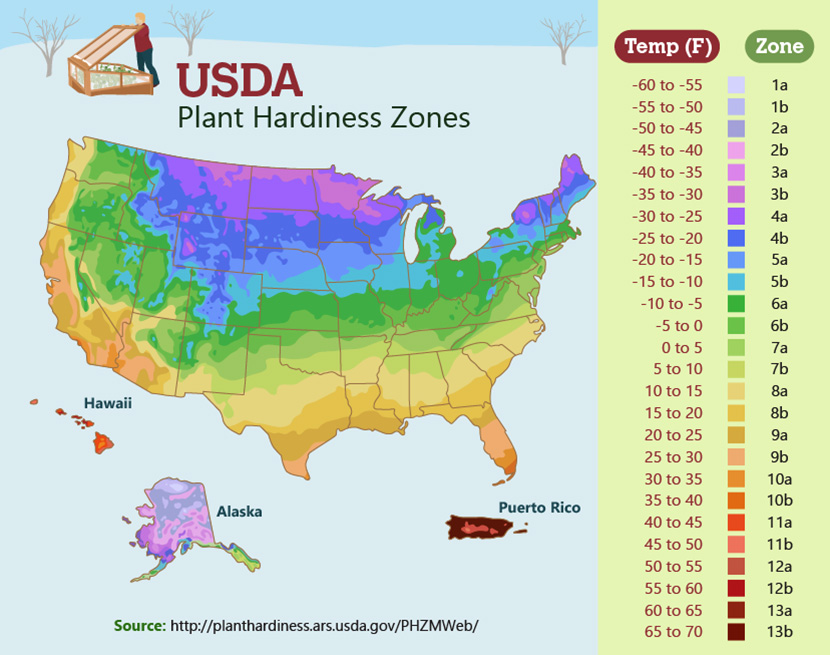
A Note on the Coldest Zones
Zones 1, 2, and 3 stretch through Alaska and most northern continental states; winter sunlight is minimal and temperatures can drop to negative 40 degrees Fahrenheit and below. Needless to say, these are challenging climates for year-round vegetable gardening. Determined gardeners can extend the regular growing season into fall by using a combination of protection devices. However, an indoor container garden under lights may be the best bet for fresh greens in the dark of January.http://northernhomestead.com/winter-growing-in-zone-3/http://www.newsminer.com/features/sundays/gardening/how-to-stretch-the-interior-alaska-growing-season/article_bca0ce52-4915-11e5-b38b-0fb5eb01e6ba.htmlhttp://northernhomestead.com/geodome-greenhouse-winter/http://www.motherearthnews.com/organic-gardening/gardening-techniques/winter-gardening-tips-zm0z13onzsto.aspx
Zone 4
This zone stretches across mountain, plains, and the New England states. It experiences heavy snow and freezing temperatures that can dip as low as negative 35 degrees Fahrenheit. Protection devices must be well built to withstand heavy snow. This is particularly important with hoop tunnels, which can collapse and crush plants. Regularly sweep snow off devices to allow light in. However, if temperatures are predicted to drop precipitously after a snowfall and the snow load is not likely to damage the protective device, leave the snow in place for a few days. It can insulate the plants, and they’ll do fine without sunlight for short periods.Coleman, Eliot, Four-Season Harvest, Chelsea Green Publishing, 1992, pg. 88
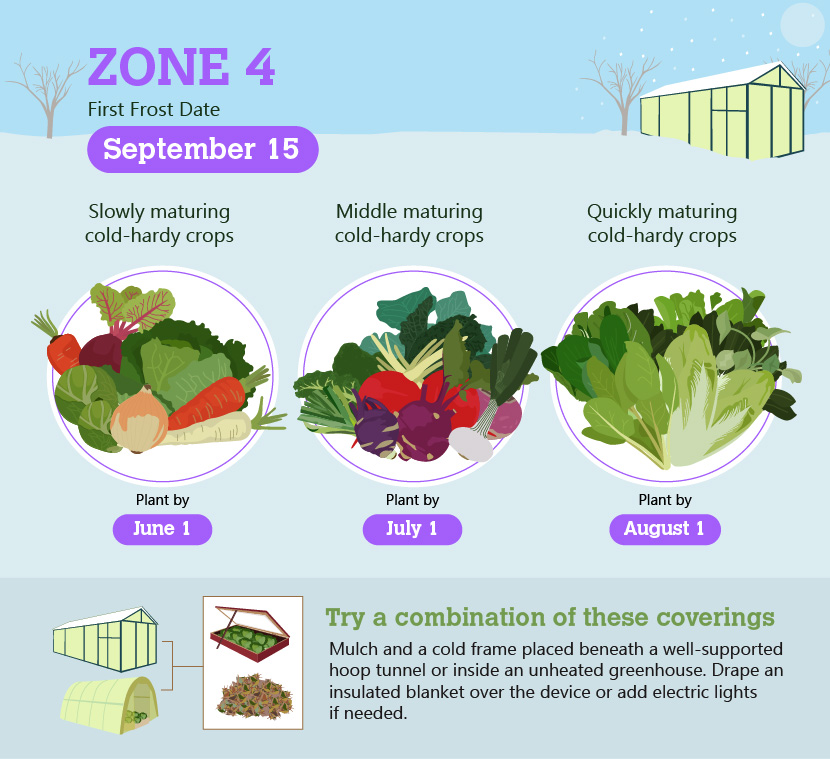
Zones 5, 6, and 7
These zones, which stretch across the middle of the country, also experience heavy snow. See Zone 4 information above for snow considerations. Winter temperatures are cold, with extreme minimum temperatures ranging from negative 29 degrees Fahrenheit to negative 16 degrees Fahrenheit. Combine a number of protection devices for the longest harvests.
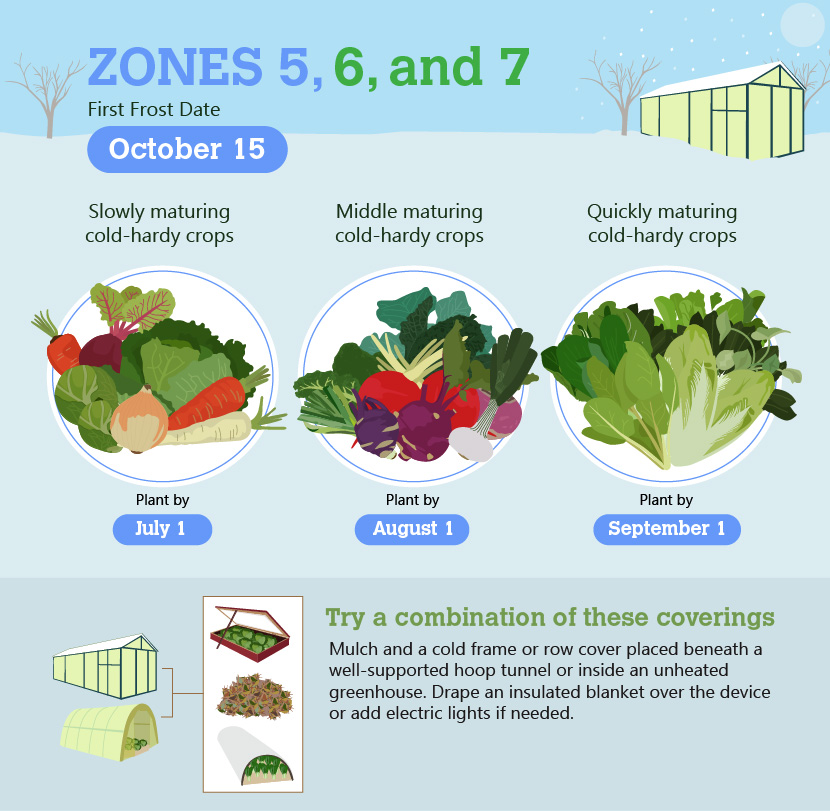
Zone 8
Temperatures usually stay above freezing in this zone but in rare cases they can dip to negative 12 degrees Fahrenheit. Some regions in this zone get snow and others get heavy rainfall. In arid areas without much wind, mulch may be the only protection needed to keep winter crops thriving most of the time. Pay attention to weather forecasts, and cover crops with fabric if freezing temperatures are predicted. Where wind is strong or rainfall is heavy, use row covers or another device to protect plants.
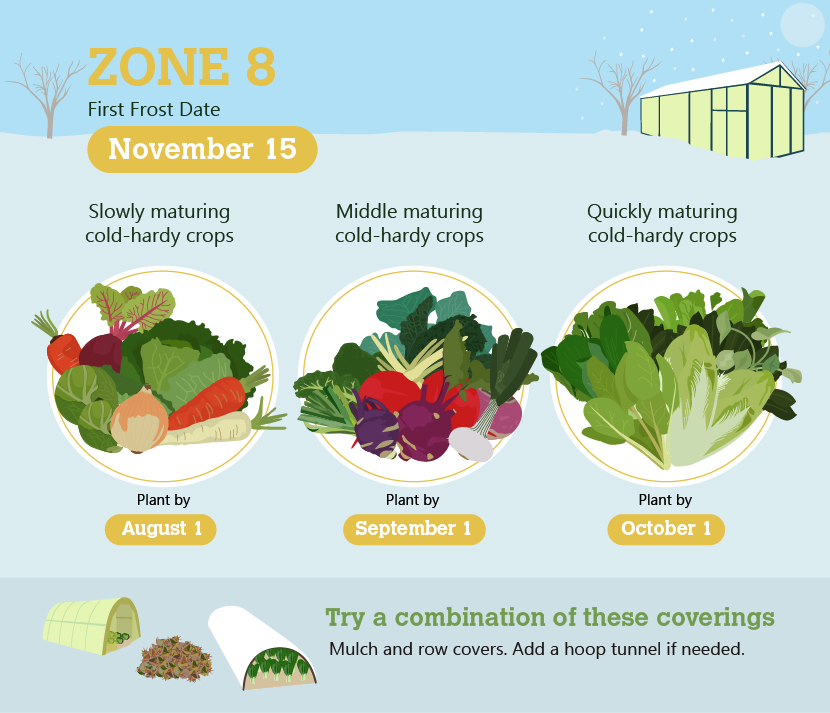
Zone 9
Temperatures are mild, and winter can actually be an easier time to grow food than summer. In semi-arid areas, mulch is usually the only protection necessary. A row cover with thin fabric may help in rainy or windy areas. If temperatures are expected to drop below freezing – it can dip to negative seven degrees Fahrenheit in extreme cases – protect plants with temporary row covers made of old sheets or cloches made of plastic milk jugs cut in half.
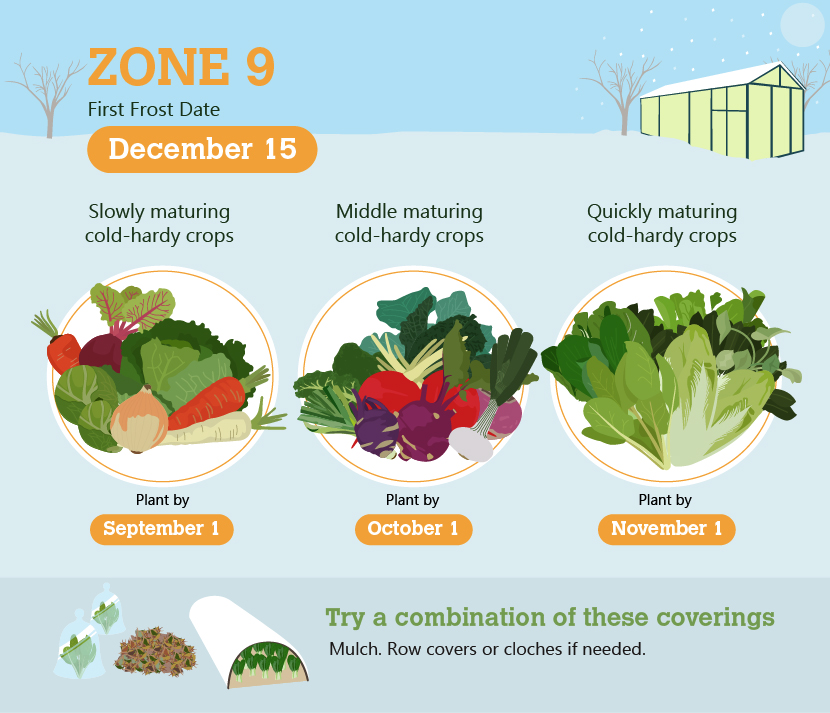
How to Water and Harvest the Winter Garden
Once the garden is planted and protection devices are in place, watering and harvesting are the main jobs of the winter gardener. Even in arid climates, winter gardens usually need less water than summer gardens because there’s less sunlight and less evaporation. Mulch further helps the soil retain water and can reduce watering needs by up to 25 percent.http://aggie-horticulture.tamu.edu/newsletters/hortupdate/hortupdate_archives/2006/nov06/ScienceFair.html Cold frames usually entirely eliminate the need to water between mid-November and mid-February in most places, and once-a-week watering generally suffices for the rest of the cold season.http://www.fourseasonfarm.com/pdfs/garden_for_all_seasons.pdf, https://eattomorrow.com/blog/2014/10/winter-gardening-tips-best-winter-crops-cold-hardy-varieties/ Hoop tunnels and cloches may similarly reduce watering needs, depending on the set-up and the climate. The best rule of thumb is to feel the soil regularly and water when it feels dry.http://www.nrcs.usda.gov/Internet/FSE_DOCUMENTS/nrcs144p2_051845.pdf Contact a local county extension office or garden center for more region-specific watering advice.
The best way to harvest a winter garden is the cut-and-come-again method. Leave the roots in the ground and clip leaves off as necessary. This practice inspires new growth and extends the life of greens. Cold-hardy plants usually withstand freezing and thawing as long as they’re in the ground, but should only be harvested when thawed. The best time is usually mid-afternoon when temperatures are above freezing, even in cold climates. Bring a covered basket or bucket to the garden to protect greens from freezing on the way back to the kitchen. Plants do not tolerate freezing once they’re out of the ground.Coleman, Eliot, Four-Season Harvest, Chelsea Green Publishing, 1992, pg. 88
Conclusion
Gardening through the frigid months is not for everyone. However, gardeners who are willing to experiment with planting cold-tolerant veggies at the right time and protecting them from the elements will be rewarded with the delicious taste of homegrown greens on the coldest, darkest days.
Embed the article on your site

